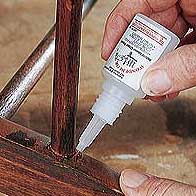
I have a kitchen chair with loose legs. How do I fix them? – Kenneth Belcher
Tim Inman: The very best way to repair those loose legs is to completely disassemble the chair, clean the joints, and reglue it. There are alternatives, but they have shortcomings. I’ll review two alternatives. First, If the joints are not too loose, or filled with layers and layers of paint, one possible alternative is to flood the joint (very carefully!) with cyanoacrylate glue. (Super Glue is one common brand name.) I prefer a CA that is “alcohol” thinned for this, because it will find its way deep into the joint through capillary action It will take care, patience and skill – and more than one application. It works well. (WARNING: Somewhere on the label will be the words, “Bonds Skin Instantly.” They ain’t kiddin’…. Be very careful.) Another alternative is to drill a tiny hole into the bottom of the joint, and inject an adhesive using a syringe. This, too, can be effective, depending upon the joint condition, the cleanliness of the joint and the kind of glue used. It can be difficult to force the glue throughout the joint. With both these methods, the joint is never cleaned. This ultimately spells trouble.
Better, though, is suggestion Number One. Take the chair apart, and do it right the first time. Clean the old glue away, fix any broken wood, and enjoy a long-lasting repair job. One little trick I can offer is to put two small pieces of removable masking tape at each joint. Number them “1” “1”, “2” “2” and so on. This helps get the exact part back in the exact location when you are ready to apply new glue and reassemble. Just match up the numbered pieces and joints – and it all comes back together like magic.
Another secret weapon I use for regluing chairs is “shrink wrap.” I think you’ll find a four-inch roll available at building stores, etc. It is common. Use it to replace clamps. It works like giant rubber bands or tourniquets. Shrink wrap banding makes bar clamps pretty much obsolete for chair gluing. It is better, faster, and easier. Make multiple “turns” until you have the pressure needed. Every “lap” adds more compression force. Be sure to set the chair on a flat surface to dry. Put a weight on the seat to hold all four legs down evenly.
Chris Marshall: With all of the forces a chair must resist (tension, compression, racking) as we drag them around, plus the weight of holding people, I’m skeptical about the strength of glue joints. Sooner or later, that glue will probably fail if the chairs get hard use. You might consider pinning the tenons in their sockets with a dowel driven into the chair legs perpendicular to the tenons. At least the dowel would provide a mechanical connection to reinforce the glue joint. If the glue does give way eventually, the cross dowels will still hold the joint together. But, you’ll see the dowel ends with this approach…that’s the price you pay for added insurance.





